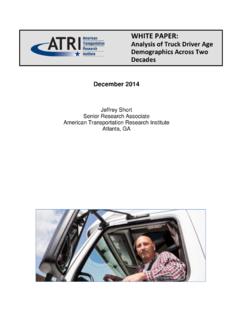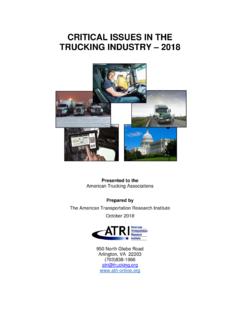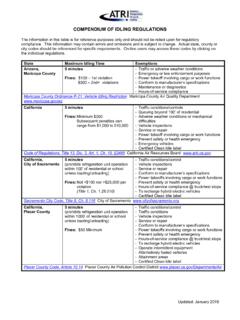Transcription of Driver Training Impacts on Safety - FINAL v4 - ATRI
1 A Technical Analysis of Driver Training Impacts ON Safety Prepared By: American Transportation Research institute May 2008 950 North Glebe Road Arlington, VA 22203 Phone: (703) 838-1966 Driver Training Impacts on Safety 2 American Transportation Research institute May 2008 Driver Training Impacts on Safety Technical Advisory Committee Mr. Chad England Vice President, Recruiting, Training and Safe Driving England, Inc. Mr. John Flanagan Manager, Quality, Safety and Fleet Services Stevens Van Lines Mr. Lon Hoepf Safety Director Nagle Toledo Inc. Mr. Mark Johnson Director of Teamsters National Training International Brotherhood of Teamsters Ms. Barbara Kennedy Vice President, and Safety Swift Transportation Company, Inc. Mr. Robert McClanahan Director central Tech Transportation & Safety Education Mr.
2 Michael O'Connell Executive Director Commercial Vehicle Training Association Mr. Mike White Commercial Truck Driving Program Coordinator Valdosta Technical College Mr. Chuck Wirth Director American institute of Technology Driver Training Impacts on Safety 3 American Transportation Research institute May 2008 Abstract This report presents the findings of the American Transportation Research institute (ATRI) study examining the relationship between Driver Training and new entrant Driver Safety performance. The research looks at the overall duration of new entrant Driver Training , the instructional environment and curriculum topic areas covered, and the relative Safety impact of each on new entrant Driver Safety performance. Background Prior to enactment of the Commercial Motor Vehicle Safety Act of 1986, there was no classified Driver licensing system in 18 states or the District of Columbia.
3 Of the 32 states with a classified Driver licensing system for commercial motor vehicle (CMV) drivers , only 12 required the operator to take a skills test in a representative commercial vehicle. When the Commercial drivers Licensing (CDL) Program was established as part of the Commercial Motor Vehicle Safety Act, it set minimum national standards that states must meet when testing and licensing CMV drivers . These federal requirements consist primarily of Driver testing criteria based on Driver knowledge and skills. Fifteen years after the implementation of the CDL program, the debate continues over the criteria that should be used to verify a Driver s qualifications to operate large commercial vehicles. While proponents of mandatory Driver Training believe that uniform Training requirements are necessary, opponents of mandatory Training argue that the emphasis should be on Driver competency rather than on learning hours.
4 Federal Government Action In 1985 the Federal Highway Administration (FHWA) Office of Motor Carriers1 published a "Model Curriculum for Training Tractor-Trailer drivers . Coming in advance of the CDL Program, the model curriculum was designed to provide non-regulatory guidelines and Training materials pertaining to vehicles, facilities, instructor hiring practices, graduation requirements and student placement. Among the curriculum content areas addressed were basic operation, safe operating practices, vehicle maintenance and non-vehicle activities. 1 The FHWA Office of Motor Carriers was the predecessor organization to the Federal Motor Carrier Safety Administration (FMCSA). Driver Training Impacts on Safety 4 American Transportation Research institute May 2008 In 2004, the Federal Motor Carrier Safety Administration (FMCSA) issued a FINAL rule on entry-level Driver Training , which focused on four topic areas: Driver medical qualification and drug and alcohol testing; Driver hours-of-service rules; Driver wellness; Whistleblower protection.
5 The 2004 rule did not mandate the number of hours of Training in each of the four topic areas. Subsequently, the Circuit Court of Appeals remanded the rule back to FMCSA for further consideration. In response, in December 2007, FMCSA published a Notice of Proposed Rulemaking (NPRM) on Entry-Level Commercial Driver Training2. Industry Training Associations Truck Driver Training programs benefit from an active industry network consisting of three major Driver Training associations described below. These associations represent distinct initiatives that bring subject-matter expertise and collaboration to the topic of Driver Training curricula and/or standards. Professional Truck Driver institute The Professional Truck Driver institute (PTDI), founded in 1986, began developing formal truck Driver Training standards in 1996. The process commenced with four industry stakeholder forums that sought input on questions such as Do the current standards fairly measure the quality of education and Training for entry-level truck drivers ?
6 And What does a Driver need to know? More than 150 stakeholders participated in the PTDI standards development and testing process. In January 1999, the FINAL PTDI standards were approved by the PTDI Board of Directors. PTDI standards are reviewed and revised on a regular basis, with the last revision occurring in 2003. At the present time, 66 Driver Training programs across the are certified according to PTDI standards. These programs are operated by motor carriers, public education institutions and private companies. Commercial Vehicle Training Association The Commercial Vehicle Training Association (CVTA) was formally established in 1996. CVTA members operate private and carrier-based instructional schools at over 180 locations, graduating approximately 50,000 students annually. While 2 Federal Motor Carrier Safety Administration (FMCSA) Proposed Rule.
7 Available at: Driver Training Impacts on Safety 5 American Transportation Research institute May 2008 CVTA does not publish a detailed Training curriculum for its members, it does evaluate schools based on adherence to the Model Curriculum. National Association of Publicly Funded Truck Driving Schools The National Association of Publicly Funded Truck Driving Schools (NAPFTDS) represents Training programs operated within public education institutions. NAPFTDS was formed in 1990 and represents over 70 Training programs. While the association does not promote a standardized Training curriculum, members discuss Training advancements and regulations at annual and regional meetings. Driver Training Research In contrast to the considerable activity taking place within government agencies and commercial vehicle Training associations, surprisingly little academic or technical research has been conducted on Driver Training .
8 In fact, research on CMV Driver Training is so sparse that baseline Driver Training data is essentially non-existent. Typical truck Driver Training questions that remain largely unanswered include: What percentage of the three million professional truck drivers in the United States received any specialized truck Driver Training before receiving a CDL? What percentage of newly issued Class A CDLs are obtained by applicants that have received specialized truck Driver Training ? What is the typical or median cost for a truck Driver Training program? What common components or standards exist across Training regimen? While answering these questions is generally beyond the scope of ATRI s research analysis, these questions serve to highlight the dearth of information that would be needed to better inform the public debate on minimum truck Driver Training standards. ATRI Approach Given the lack of available research on mandatory entry-level Driver Training , the Research Advisory Committee of the American Transportation Research institute (ATRI) identified a Driver Training study as a priority issue.
9 ATRI s research focuses on the critical relationship between Driver Training and Safety among new entrant drivers . As the first known examination of the Safety impact of Training on new entrant drivers , the study methodology collected and Driver Training Impacts on Safety 6 American Transportation Research institute May 2008 analyzed the statistical relationship between Driver Training regimens and the Safety records of the new Driver registrants that attended each program. The study design attempted to identify and isolate the Training program curriculum components that have the greatest impact on Driver Safety , and determine whether certain curriculum components have a greater influence on Driver Safety outcomes than other factors. After an initial review of existing literature (Appendix A), ATRI convened a Technical Advisory Committee (TAC) to oversee the research and provide guidance on the study methodology and findings.
10 The TAC consists of individuals involved with leading truck Driver Training associations (CVTA, NAPFTDS, PTDI), Safety and Training managers from representative motor carrier segments and Driver trainers currently employed in day-to-day instruction. Driver Training Impacts on Safety 7 American Transportation Research institute May 2008 methodology This study analyzed the relationship between entry-level Driver Training curricula and Safety performance, with Training program exposure serving as the independent variable and individual Driver Safety outcomes serving as the dependent variable. Safety outcomes are measured by the drivers involvement in Department of Transportation ( DOT) reportable accidents, separate property damage only (PDO) accidents and traffic convictions. In an effort to adjust for exposure, all Safety variables are controlled by length of employment, measured in days.














